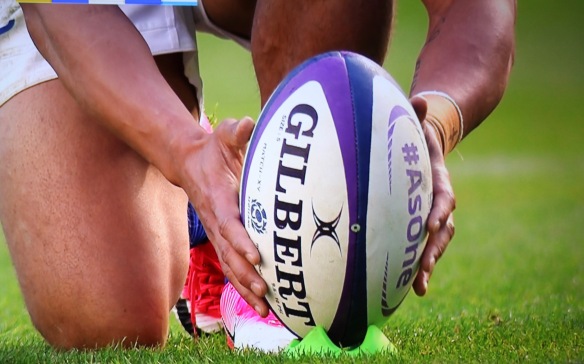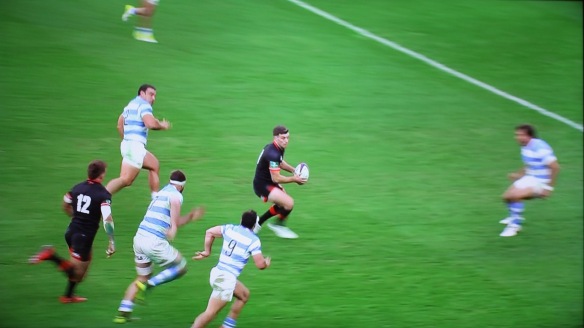CLICK ON IMAGES TO ENLARGE. REPEAT IF REQUIRED
This afternoon rugby’s autumn internationals began. On television I watched Scotland v Samoa; Wales v Australia; and the highlights of England v Argentina. I made a few photographs direct from the screen, cropping out the score lines from the top left hand corners in order not to reveal the results to anyone who has recorded the matches.
Here, in the first match, a player who has been tackled attempts to release the ball;
this time it has been released.
Here the chase is on,
ending with a tussle on the touchline.
Certain infringements result in the setting of scrums where the opposing two sets of eight forwards bind onto each other pushing for possession of the ball tossed between them by the scrum half, here standing poised;
and here placing the ball into the mêlée.
There are strict rules of engagement determining how the teams pack down, demanding a pause at each stage.
Sometimes loose scrums form in play. The ball is then sent back to one’s own side.
It is the scrum half’s job to pick it up and pass it back along the line of players.
This is how the teams position themselves when there has been a scrum wrestling over possession.
Tries are scored when the ball is grounded
across the opposing goal line.
Sometimes it is reasonably clear that that has happened;
at others it is rather less than apparent.
The man on the ground, having been scragged, has managed here to pass the ball to a team member who is heading for the try, or goal, line. The referee, in order to keep up with the game, is in hot pursuit.
A try is worth five points. Two more may be added by placing the ball on a tee
and kicking it
between the goal posts above the cross bar to perform a conversion.
Careful concentration is required
from the specialists who perform this task.
Instructions are periodically mouthed from behind the ball in order to prevent lip-reading.
Team mates generally attempt to pound along in support of those with
or chasing the ball.
Occasionally one man will get clean away
on his own;
or have a cluster of opposition players between him and his support.
Hands and feet compete with each other over the ball.
When the ball has been kicked into touch, or out of play, the two sets of forwards line up alongside each other, it is then thrown between them and caught by one of the players who may be lifted to aid his jump.
When spectators spot themselves on the large television screen at the ground, they generally attempt to catch the attention of their friends at home.
Others check out their own photographs on their mobile devices.
It is quite usual for medical attention to be required. Injuries may be comparatively slight;
if a player is bleeding he must leave the field to be stitched up and/or bandaged, and may be temporarily replaced by ‘a blood replacement’.
Medics may step onto the field to assess damage and offer assistance. When this gentleman took a break, the commentator offered the opinion that he had “taken a knock in his undercarriage”.
The opposing players may be tackled by wrapping arms around them as you charge into them.
This cannot be above shoulder height.
It is not permitted to tackle a player in the air;
and if you up-end him you are responsible for his landing safely.
For those unfamiliar with our more civilised national game, I hope this has made it a little more comprehensible.
This evening Jackie and I dined on Mr Chan’s Hordle Chinese Take Away with which I drank more of the malbec.





































